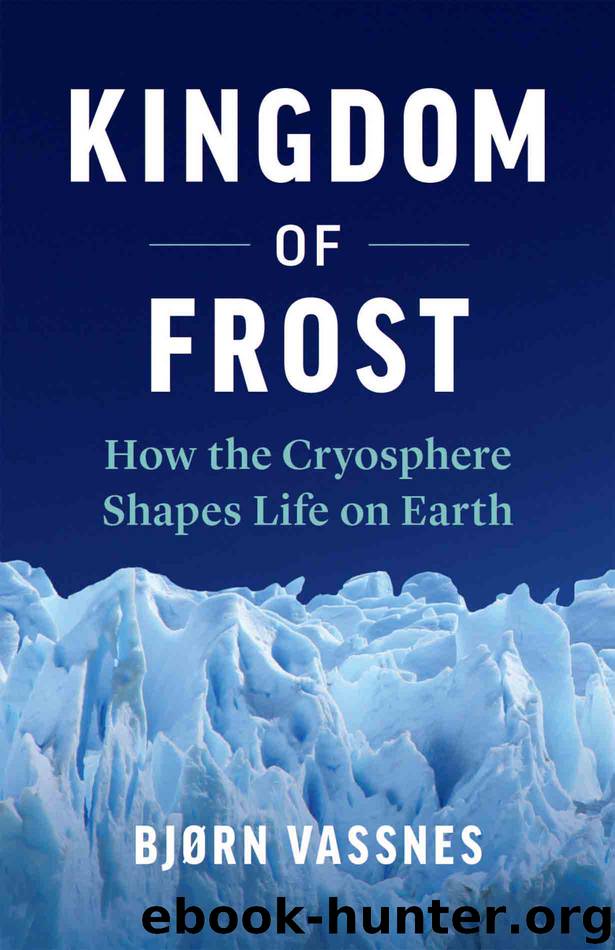Kingdom of Frost by Bjørn Vassnes

Author:Bjørn Vassnes
Language: eng
Format: epub
Publisher: Greystone Books
Published: 2020-03-15T00:00:00+00:00
A CLOSER LOOK
The Cryosphere Today
The factor that determines the size of the cryosphere is which areas experience temperatures below the freezing point of water over the course of the year. This criterion applies to 35 percent of the Earth’s surface, including around half of the land surface.
When we talk about the cryosphere, we generally think of the “eternal” ice, the glaciers. These cover 10.8 percent of the land surface, and the largest ones are the Greenland and Antarctic ice sheets. Of the total 6.2 million square miles of glaciers, the Antarctic accounts for 5.3 million and Greenland for 672,000. The remainder, about 200,000 square miles, is spread across the globe. An even larger fraction of the “eternal” ice belongs to the Antarctic and Greenland if you factor in volume or weight, because those ice sheets are so thick. The ice in the Antarctic accounts for 6.09 million cubic miles of the 6.86 million total, and the ice in Greenland for 696,000. As I’ve noted, if all the ice in Greenland melted, sea level would rise 23 feet; if the same happened in the Antarctic, there would be a rise of 184 feet.
The glaciers are not the only form of permanent frost. Permafrost also covers a large area: 8.8 million square miles, although it is smaller than the glaciers if measured by volume. It covers 15.4 percent of the Earth’s land surface, mostly in Siberia and Canada (as well as islands in the Arctic Ocean), and can be over a thousand feet deep.
The variable cryosphere is an especially interesting factor for the climate and can trigger strong feedback effects. I am referring here to sea ice and snow cover, but also those parts of the permafrost that vary with the seasons. Sea ice is the one people have focused on most, especially in the Arctic. The shrinking ice around the North Pole has become a symbol of climate change. The reduction in sea ice opens up opportunities for shipping, as well as the extraction of oil and minerals, but it also creates a dangerous feedback effect: the increase in open sea in the Arctic means that the ocean will absorb more solar energy, while less will be reflected back into the atmosphere. This accelerates warming, especially in the Arctic, where the temperature is climbing more quickly than anywhere else on the planet. The most recent reports indicate that Arctic Ocean ice may be totally gone in just a few decades, for much of the year at least.
The situation in the south is a bit different, because in this case a continent, Antarctica, covers a large area around the South Pole. Although little of the sea ice here is multiyear, it forms over a larger area in winter than in the north, reaching a maximum of 5.6 million square miles in September.
Snow cover is an even more variable part of the cryosphere. The variations are greatest in the northern hemisphere. Most of the snow in the southern hemisphere is in the Antarctic,
Download
This site does not store any files on its server. We only index and link to content provided by other sites. Please contact the content providers to delete copyright contents if any and email us, we'll remove relevant links or contents immediately.
Man-made Catastrophes and Risk Information Concealment by Dmitry Chernov & Didier Sornette(4730)
The Revenge of Geography: What the Map Tells Us About Coming Conflicts and the Battle Against Fate by Kaplan Robert D(3596)
Zero Waste Home by Bea Johnson(3286)
COSMOS by Carl Sagan(2944)
In a Sunburned Country by Bill Bryson(2941)
Good by S. Walden(2910)
The Fate of Rome: Climate, Disease, and the End of an Empire (The Princeton History of the Ancient World) by Kyle Harper(2431)
Camino Island by John Grisham(2379)
A Wilder Time by William E. Glassley(2358)
Organic Mushroom Farming and Mycoremediation by Tradd Cotter(2304)
Human Dynamics Research in Smart and Connected Communities by Shih-Lung Shaw & Daniel Sui(2175)
The Ogre by Doug Scott(2105)
Energy Myths and Realities by Vaclav Smil(2054)
The Traveler's Gift by Andy Andrews(2008)
Inside the Middle East by Avi Melamed(1937)
Birds of New Guinea by Pratt Thane K.; Beehler Bruce M.; Anderton John C(1905)
Ultimate Navigation Manual by Lyle Brotherton(1764)
A History of Warfare by John Keegan(1712)
And the Band Played On by Randy Shilts(1612)
